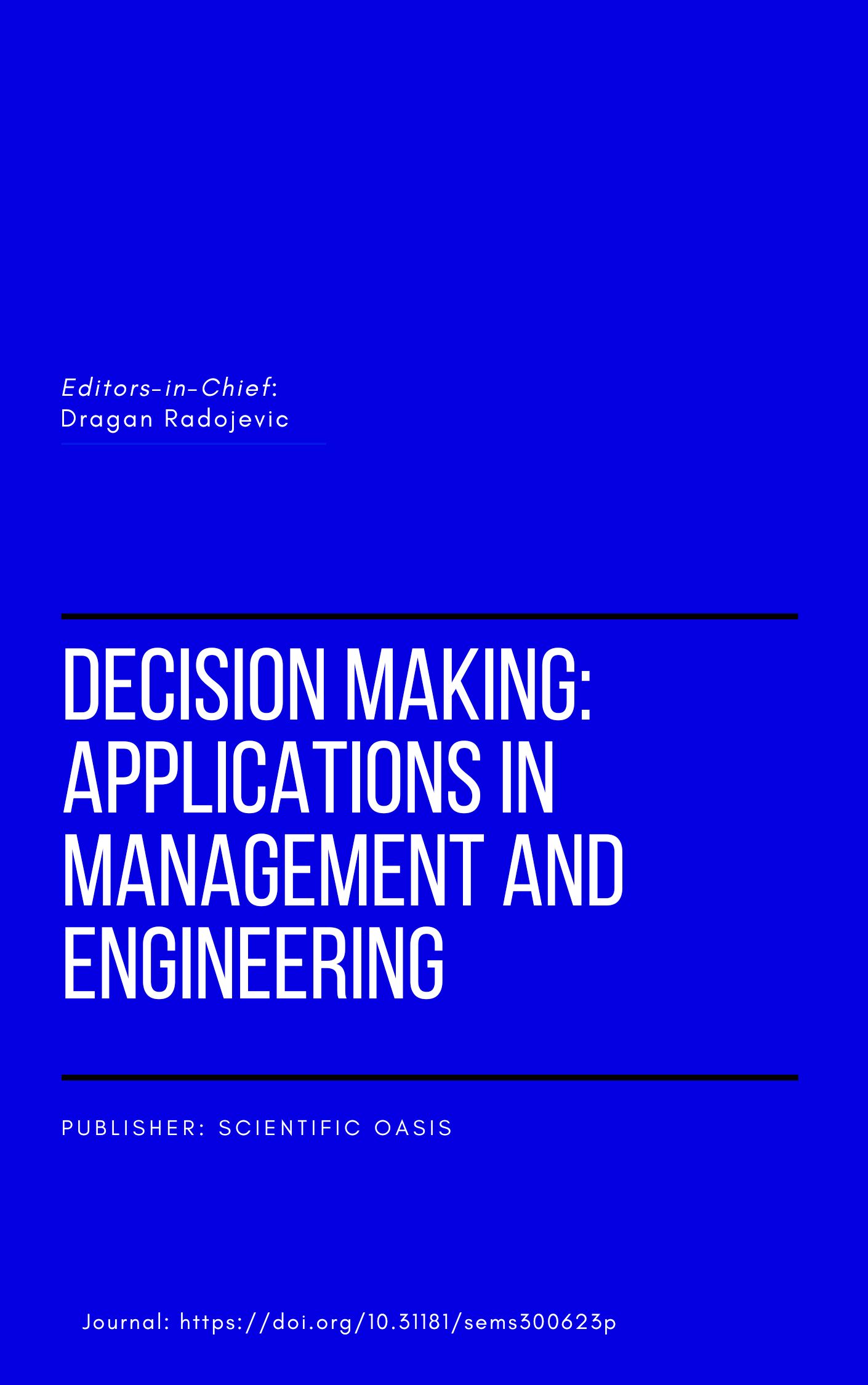AI-Driven Financial Risk Early-Warning Using TD-DS-RF: A Decision Support Model Integrating Multi-Source Data
DOI:
https://doi.org/10.31181/dmame8120251391Keywords:
Two-Dimensional Evidence Theory; Random Forest Algorithm; Financial Risk Early-Warning; Management Discussion and Analysis; Decision-Making SupportAbstract
With the swift advancement of information technology, digitalisation and intelligence have emerged as intrinsic drivers of reform and progress in enterprise risk management. Conventional approaches to financial risk early-warning predominantly rely on structured data, exhibit limited exploration of unstructured information, inadequately address the varying quality of information sources, and generally apply uniform treatment to multi-source data. In response to these shortcomings, the present study harnesses the advantages of evidence theory in managing uncertain information fusion by incorporating two-dimensional evidence theory into the financial risk early-warning framework. By integrating this with a random forest algorithm, a novel financial risk early-warning model—termed TD-DS-RF (Two-Dimensional Dempster-Shafer with Random Forest)—is established. Additionally, a financial risk early-warning lexicon is devised for publicly listed enterprises. Empirical validation utilises data from Chinese manufacturing firms listed between 2012 and 2021. The findings affirm that the TD-DS-RF model exhibits strong performance in real-world contexts, furnishing reliable decision-making support for both stakeholders and regulatory bodies, while contributing a novel conceptual lens to the domain of financial risk early-warning.
Downloads
References
[1] Sarlin, P. (2014). On biologically inspired predictions of the global financial crisis. Neural Computing and Applications, 24, 663-673. https://doi.org/10.1007/s00521-012-1281-y DOI: https://doi.org/10.1007/s00521-012-1281-y
[2] Liu, W., Fan, H., Xia, M., & Pang, C. (2022). Predicting and interpreting financial distress using a weighted boosted tree-based tree. Engineering Applications of Artificial Intelligence, 116, 105466. https://doi.org/10.1016/j.engappai.2022.105466
[3] Zhu, W., Zhang, T., Wu, Y., Li, S., & Li, Z. (2022). Research on optimization of an enterprise financial risk early warning method based on the DS-RF model. International review of financial analysis, 81, 102140. https://doi.org/10.1016/j.irfa.2022.102140
[4] Huang, Y.-P., & Yen, M.-F. (2019). A new perspective of performance comparison among machine learning algorithms for financial distress prediction. Applied Soft Computing, 83, 105663. https://doi.org/10.1016/j.asoc.2019.105663
[5] Mousavi, M. M., & Lin, J. (2020). The application of PROMETHEE multi-criteria decision aid in financial decision making: Case of distress prediction models evaluation. Expert Systems with Applications, 159, 113438. https://doi.org/10.1016/j.eswa.2020.113438
[6] Li, Z., Crook, J., Andreeva, G., & Tang, Y. (2021). Predicting the risk of financial distress using corporate governance measures. Pacific-Basin Finance Journal, 68, 101334. https://doi.org/10.1016/j.pacfin.2020.101334
[7] Muñoz-Izquierdo, N., Camacho-Miñano, M.-d.-M., Segovia-Vargas, M.-J., & Pascual-Ezama, D. (2019). Is the external audit report useful for bankruptcy prediction? Evidence using artificial intelligence. International Journal of Financial Studies, 7(2), 20. https://doi.org/10.3390/ijfs7020020
[8] Donovan, J., Jennings, J., Koharki, K., & Lee, J. (2021). Measuring credit risk using qualitative disclosure. Review of Accounting Studies, 26, 815-863. https://doi.org/10.1007/s11142-020-09575-4
[9] Mselmi, N., Lahiani, A., & Hamza, T. (2017). Financial distress prediction: The case of French small and medium-sized firms. International review of financial analysis, 50, 67-80. https://doi.org/10.1016/j.irfa.2017.02.004 DOI: https://doi.org/10.1016/j.irfa.2017.02.004
[10] Li, X., Wang, J., & Yang, C. (2023). Risk prediction in financial management of listed companies based on optimized BP neural network under digital economy. Neural Computing and Applications, 35(3), 2045-2058. https://doi.org/10.1007/s00521-022-07377-0
[11] Li, C., Jin, K., Zhong, Z., Zhou, P., & Tang, K. (2021). Financial risk early warning model of listed companies under rough set theory using BPNN. Journal of Global Information Management (JGIM), 30(7), 1-18. https://doi.org/10.4018/JGIM.300742
[12] Altman, E. I. (1968). Financial ratios, discriminant analysis and the prediction of corporate bankruptcy. The journal of finance, 23(4), 589-609. https://doi.org/10.2307/2978933 DOI: https://doi.org/10.1111/j.1540-6261.1968.tb00843.x
[13] Chen, P. (2023). RETRACTED ARTICLE: Research on Financial Risk Evaluation and Control of Tourism Enterprises Based on Improved GA Algorithm. International Journal of Computational Intelligence Systems, 16(1), 146. https://doi.org/10.1007/s44196-023-00317-3
[14] Lin, G., & Chen, W. (2022). Early warning method for enterprise financial informatisation caused by tax difference. International Journal of Information Technology and Management, 21(2-3), 248-263. https://doi.org/10.1504/IJITM.2022.123404
[15] Manzaneque, M., & Priego, A. M. (2016). Corporate governance effect on financial distress likelihood: Evidence from Spain: Efecto del gobierno corporativo en la probabilidad de fracaso empresarial: evidencia española. Revista de Contabilidad-Spanish Accounting Review, 19(1), 111-121. https://doi.org/10.1016/j.rcsar.2015.04.001 DOI: https://doi.org/10.1016/j.rcsar.2015.04.001
[16] Lee, A., & Chae, S.-J. (2018). The effect of management disclosure and analysis on the stock crash risk: Evidence from Korea. The Journal of Asian Finance, Economics and Business, 5(4), 67-72. https://doi.org/10.13106/jafeb.2018.vol5.no4.67
[17] Park, H., & Lee, A. (2016). MD&A disclosure quality and the Accuracy of management forecasts. Review of Accounting & Policy Studies, 21(21), 185-210. https://doi.org/10.7469/JKSQM.2022.50.4.735 DOI: https://doi.org/10.21737/kjar.2016.04.21.2.185
[18] Loughran, T., & McDonald, B. (2011). When is a liability not a liability? Textual analysis, dictionaries, and 10‐Ks. The journal of finance, 66(1), 35-65. https://doi.org/10.1111/j.1540-6261.2010.01625.x DOI: https://doi.org/10.1111/j.1540-6261.2010.01625.x
[19] Brown, S. V., & Tucker, J. W. (2011). Large‐sample evidence on firms’ year‐over‐year MD&A modifications. Journal of Accounting Research, 49(2), 309-346. https://doi.org/10.1111/j.1475-679X.2010.00396.x DOI: https://doi.org/10.1111/j.1475-679X.2010.00396.x
[20] Wang, G., Chen, G., & Chu, Y. (2018). A new random subspace method incorporating sentiment and textual information for financial distress prediction. Electronic Commerce Research and Applications, 29, 30-49. https://doi.org/10.1016/j.elerap.2018.03.004 DOI: https://doi.org/10.1016/j.elerap.2018.03.004
[21] Cecchini, M., Aytug, H., Koehler, G. J., & Pathak, P. (2010). Making words work: Using financial text as a predictor of financial events. Decision support systems, 50(1), 164-175. https://doi.org/10.1016/j.dss.2010.07.012 DOI: https://doi.org/10.1016/j.dss.2010.07.012
[22] Cohen, D. A., Dey, A., & Lys, T. Z. (2008). Real and accrual‐based earnings management in the pre‐and post‐Sarbanes‐Oxley periods. The accounting review, 83(3), 757-787. https://doi.org/10.2308/accr.2008.83.3.757 DOI: https://doi.org/10.2308/accr.2008.83.3.757
[23] Tang, X., Li, S., Tan, M., & Shi, W. (2020). Incorporating textual and management factors into financial distress prediction: A comparative study of machine learning methods. Journal of Forecasting, 39(5), 769-787. https://doi.org/10.1002/for.2661
[24] Fitzpatrick, P. J. (1932). A comparison of the ratios of successful industrial enterprises with those of failed companies. https://openlibrary.org/books/OL6298050M
[25] Sun, X., & Lei, Y. (2021). Research on financial early warning of mining listed companies based on BP neural network model. Resources Policy, 73, 102223. https://doi.org/10.1016/j.resourpol.2021.102223
[26] Qian, H., Wang, B., Yuan, M., Gao, S., & Song, Y. (2022). Financial distress prediction using a corrected feature selection measure and gradient boosted decision tree. Expert Systems with Applications, 190, 116202. https://doi.org/10.1016/j.eswa.2021.116202
[27] Zhao, Z., Li, D., & Dai, W. (2023). Machine-learning-enabled intelligence computing for crisis management in small and medium-sized enterprises (SMEs). Technological Forecasting and Social Change, 191, 122492. https://doi.org/10.1016/j.techfore.2023.122492
[28] Shafer, G. (1976). A Mathematical Theory of Evidence. https://philpapers.org/rec/SHAAMT
[29] Tong, Y., Zhao, R., Ye, W., & Li, D. (2016). Research on energy efficiency evaluation for overhead crane. Kybernetes, 45(5), 788-797. https://doi.org/10.1108/K-09-2015-0225 DOI: https://doi.org/10.1108/K-09-2015-0225
[30] Zhang, T., Zhu, W., Wu, Y., Wu, Z., Zhang, C., & Hu, X. (2023). An explainable financial risk early warning model based on the DS-XGBoost model. Finance Research Letters, 56, 104045. https://doi.org/10.1016/j.frl.2023.104045
[31] Zhu, W., Ku, Q., Wu, Y., Zhang, H., Sun, Y., & Zhang, C. (2018). A research into the evidence reasoning theory of two-dimensional framework and its application. Kybernetes, 47(5), 873-887. https://doi.org/10.1108/K-05-2017-0156 DOI: https://doi.org/10.1108/K-05-2017-0156
[32] Zhu, W., Li, S., Zhang, H., Zhang, T., & Li, Z. (2022). Evaluation of scientific research projects on the basis of evidential reasoning approach under the perspective of expert reliability. Scientometrics, 1-24. https://doi.org/10.1007/s11192-021-04201-9
[33] Mikolov, T., Chen, K., Corrado, G., & Dean, J. (2013). Efficient estimation of word representations in vector space. arXiv preprint arXiv:1301.3781. https://doi.org/10.48550/arXiv.1301.3781
Downloads
Published
How to Cite
Issue
Section
License
Copyright (c) 2025 Decision Making: Applications in Management and Engineering

This work is licensed under a Creative Commons Attribution 4.0 International License.












